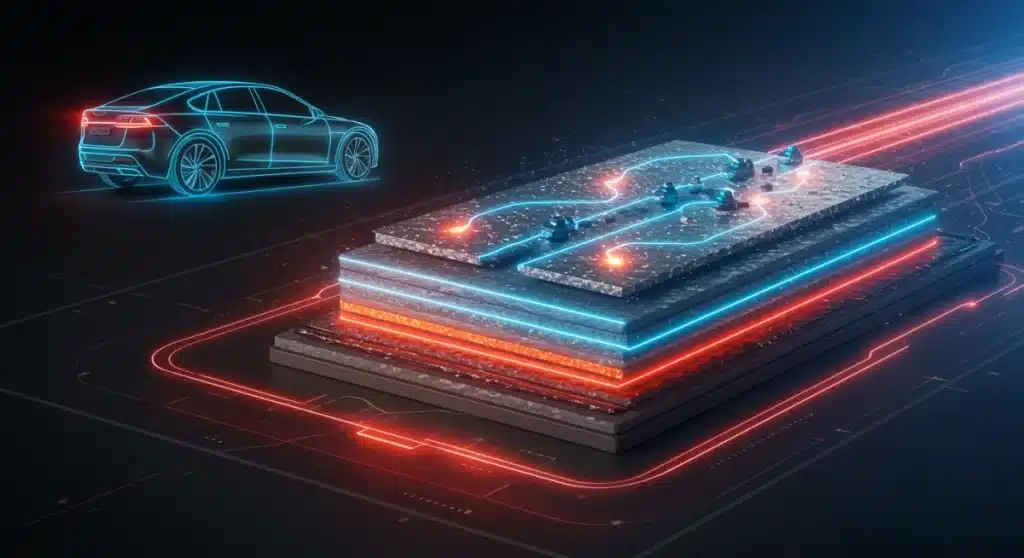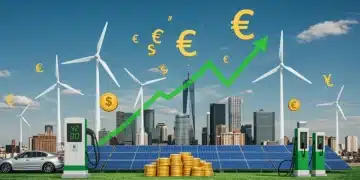EV Battery Breakthroughs Expected by Mid-2025: What’s Next

Significant advancements in electric vehicle battery technology are anticipated by mid-2025, promising to deliver enhanced range, faster charging capabilities, and improved affordability that will redefine the electric vehicle market.
The automotive industry stands on the cusp of a transformative era as significant electric vehicle battery technology breakthroughs expected by mid-2025 are set to redefine performance, cost, and adoption. These imminent innovations promise to address critical challenges, making EVs more accessible and efficient for consumers worldwide. The next 18 months are crucial for these developments.
Solid-State Batteries: The Next Frontier
Solid-state batteries represent one of the most anticipated advancements in EV power. Unlike traditional lithium-ion batteries that use liquid electrolytes, solid-state batteries employ solid materials, offering significant advantages in energy density, safety, and charging speed. This shift is poised to dramatically alter the landscape of electric transportation.
Leading research institutions and automotive manufacturers are aggressively pursuing solid-state technology, with several prototypes demonstrating impressive performance. Companies like Toyota, Nissan, and QuantumScape have made public statements regarding their progress, indicating a potential market introduction sooner than previously expected. The focus is not just on performance but also on scaling production efficiently.
Enhanced Energy Density and Safety
The primary appeal of solid-state batteries lies in their ability to store more energy in a smaller, lighter package. This translates directly to increased driving range for electric vehicles without adding significant weight or bulk. Furthermore, the absence of flammable liquid electrolytes substantially reduces the risk of thermal runaway and fires, a critical safety concern for current EV batteries.
- Increased Range: Expect vehicles to achieve 500+ miles on a single charge.
- Improved Safety: Reduced risk of fire due to solid electrolyte.
- Compact Design: Smaller battery packs allow for more interior space or sleeker vehicle designs.
Silicon Anode Advancements
While solid-state batteries capture headlines, incremental yet impactful improvements in existing lithium-ion technology are also crucial. Silicon anode batteries are emerging as a bridge technology, offering a substantial boost in energy density over conventional graphite anodes. This innovation is already seeing limited integration and is expected to become more widespread by mid-2025.
The challenge with silicon has historically been its tendency to expand and contract significantly during charging and discharging cycles, leading to structural degradation and reduced battery life. However, recent breakthroughs in material science and cell design have largely mitigated these issues, making silicon a viable and attractive material for future EV batteries. Companies like StoreDot and Sila Nanotechnologies are at the forefront of these developments, showcasing impressive results in their prototypes.
Faster Charging Capabilities
Beyond energy density, silicon anode technology is also contributing to faster charging times. The unique properties of silicon allow for quicker absorption of lithium ions, translating to significantly reduced charging durations. This is a key factor in addressing range anxiety and making EVs more appealing to a broader consumer base.
- Rapid Charging: Potential for 0-80% charge in under 15 minutes.
- Higher Energy Density: Up to 20-40% improvement over graphite anodes.
- Longer Cycle Life: New designs address expansion issues, extending battery longevity.
![]()
Sodium-Ion Batteries: The Cost-Effective Alternative
As the demand for electric vehicles surges, so does the need for more sustainable and cost-effective battery materials. Sodium-ion batteries are gaining significant traction as a promising alternative to lithium-ion, particularly for entry-level EVs and grid storage applications. This technology leverages abundant and inexpensive sodium, reducing reliance on finite and often geopolitically sensitive lithium resources.
While sodium-ion batteries currently offer lower energy density compared to their lithium counterparts, rapid development is closing this gap. Companies such as CATL and Faradion are already producing sodium-ion cells, with several automakers exploring their integration into upcoming models. The focus is on balancing performance with significantly reduced production costs, making EVs more affordable for a wider demographic. These advancements are critical for the overall growth and sustainability of the electric vehicle market, addressing both economic and environmental concerns.
Reduced Material Costs and Supply Chain Resilience
The primary advantage of sodium-ion batteries lies in the ubiquitous availability of sodium, which is far more abundant and geographically dispersed than lithium. This translates to lower material costs and a more resilient supply chain, less susceptible to price volatility and geopolitical disruptions. For manufacturers, this means more stable production costs and, ultimately, more competitive pricing for electric vehicles, which is a significant factor in accelerating mass adoption.
- Lower Cost: Significantly cheaper raw materials compared to lithium.
- Abundant Resources: Sodium is widely available, reducing supply chain risks.
- Improved Sustainability: Less reliance on rare earth metals and critical minerals.
Advanced Battery Management Systems (BMS)
Beyond the chemical composition of batteries, advancements in Battery Management Systems (BMS) are equally critical for optimizing performance, extending lifespan, and ensuring safety. Modern BMS are becoming increasingly sophisticated, leveraging artificial intelligence and machine learning to precisely monitor and control every aspect of battery operation. These systems are essential for maximizing the benefits of new battery chemistries like solid-state and silicon anodes.
A highly intelligent BMS can predict potential issues, balance cell voltages, manage thermal runaway, and optimize charging and discharging profiles to prevent degradation. This proactive management ensures that the battery operates within its optimal parameters, leading to a longer operational life and consistent performance throughout the vehicle’s lifespan. Companies like Texas Instruments and Analog Devices are pushing the boundaries of what’s possible with integrated circuits and software for BMS.
AI-Powered Optimization and Predictive Maintenance
The integration of AI into BMS allows for real-time adjustments based on driving patterns, environmental conditions, and battery aging. This intelligent optimization helps in maximizing the range and efficiency of the vehicle while providing predictive maintenance alerts to owners. Such systems are crucial for making the most of the electric vehicle battery technology breakthroughs expected by mid-2025.
- Extended Battery Life: AI-driven optimization minimizes degradation.
- Enhanced Safety: Real-time monitoring and anomaly detection.
- Improved Efficiency: Precise energy management for maximum range.
Infrastructure and Charging Innovations
The rapid evolution of battery technology necessitates parallel advancements in charging infrastructure. Faster charging capabilities demand more powerful and efficient charging stations, and significant efforts are underway to meet this growing need. Companies and governments are investing heavily in expanding the charging network and developing next-generation charging solutions that can handle the increased power demands of future EVs.
Innovations include ultra-fast DC chargers, smart charging networks that optimize power delivery based on grid demand, and even wireless charging technologies. These infrastructure developments are crucial for realizing the full potential of the electric vehicle battery technology breakthroughs expected by mid-2025, ensuring that drivers can conveniently and quickly recharge their vehicles, making long-distance travel as seamless as with gasoline-powered cars. The integration of renewable energy sources into charging stations is also a key focus, promoting a truly sustainable ecosystem.
Ultra-Fast Charging and Grid Integration
The deployment of ultra-fast charging stations, capable of delivering hundreds of kilowatts, is accelerating. These stations are designed to provide a significant charge in minutes, aligning with the rapid charging capabilities of new battery chemistries. Furthermore, smart grid integration allows charging stations to interact with the electrical grid, optimizing energy consumption and potentially utilizing renewable energy sources more effectively.
- Rapid Charging Networks: Widespread deployment of 350 kW+ chargers.
- Smart Grid Integration: Optimized energy use and load balancing.
- Wireless Charging: Emerging technologies for convenient, cable-free charging.
Recycling and Sustainability in Battery Production
As electric vehicle adoption grows, the environmental impact of battery production and disposal becomes a paramount concern. Significant strides are being made in battery recycling technologies and sustainable manufacturing practices to ensure that the EV revolution is truly green. These efforts are crucial for securing a circular economy for batteries, reducing the reliance on virgin materials, and minimizing waste, aligning with broader environmental goals.
New methods for extracting valuable materials like lithium, cobalt, and nickel from spent batteries are becoming more efficient and economically viable. Companies are also exploring second-life applications for EV batteries, where they can be repurposed for grid storage or other less demanding uses before final recycling. These initiatives are essential for the long-term sustainability of the electric vehicle industry and are a key focus alongside the electric vehicle battery technology breakthroughs expected by mid-2025.
Circular Economy for EV Batteries
The development of advanced recycling processes aims to recover nearly all precious materials from end-of-life EV batteries. This not only reduces environmental impact but also creates a more sustainable and resilient supply chain for battery components. Additionally, giving batteries a ‘second life’ in stationary energy storage applications extends their utility and further reduces waste.
- Efficient Material Recovery: New processes for high-yield recycling.
- Second-Life Applications: Repurposing batteries for grid storage.
- Reduced Environmental Footprint: Sustainable manufacturing and waste reduction.
| Key Breakthrough | Expected Impact by Mid-2025 |
|---|---|
| Solid-State Batteries | Significantly increased range (500+ miles) and enhanced safety due to solid electrolytes. |
| Silicon Anodes | Faster charging (0-80% in <15 min) and 20-40% higher energy density than current tech. |
| Sodium-Ion Batteries | Lower cost EVs and reduced reliance on lithium, improving affordability and supply chain resilience. |
| Advanced BMS | AI-powered optimization for extended battery life, enhanced safety, and improved efficiency. |
Frequently Asked Questions About EV Battery Technology
Solid-state batteries use solid electrolytes instead of liquid ones, offering higher energy density, faster charging, and improved safety. They are crucial for increasing EV range significantly and reducing fire risks, making electric vehicles more competitive with gasoline cars.
Silicon anode technology allows for higher energy storage in lithium-ion batteries, leading to greater driving range. Crucially, it also enables much faster charging times, potentially reducing charge durations by half, which addresses a major concern for potential EV buyers.
Yes, sodium-ion batteries are a highly viable alternative, especially for affordable EVs and stationary storage. They use abundant sodium, reducing costs and supply chain dependencies, though their energy density is currently lower. They are key for democratizing EV ownership.
Advanced BMS are essential for optimizing the performance, safety, and lifespan of new EV batteries. They use AI to monitor and control battery operations, ensuring efficient charging, preventing degradation, and providing predictive maintenance, maximizing the benefits of technological breakthroughs.
These breakthroughs will necessitate more powerful and efficient charging infrastructure. Ultra-fast DC chargers will become standard to match rapid battery charging capabilities. Smart grid integration and wireless charging will also expand, ensuring convenient and sustainable energy delivery for future EVs.
What Happens Next
The anticipated electric vehicle battery technology breakthroughs expected by mid-2025 signal a pivotal moment for the automotive sector. As these innovations move from laboratories to mass production, consumers can expect a new generation of EVs offering unprecedented range, charging speed, and affordability. Industry leaders and startups are locked in a race to commercialize these technologies, with significant investments pouring into research and manufacturing facilities. The coming months will reveal which companies successfully integrate these advancements into their vehicles, ultimately shaping the competitive landscape and accelerating the global shift towards sustainable transportation. Watch for announcements from major automakers and battery developers as they unveil their next-generation offerings, which will undoubtedly set new benchmarks for electric mobility.





